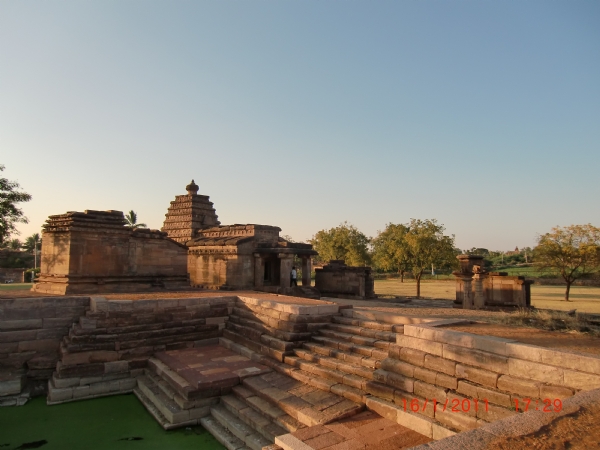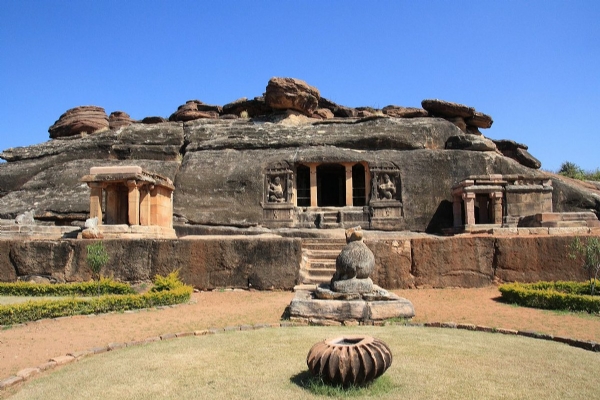Aihole’s 1000-year-old Mallikarjuna temple
These more than 1300-year-old temples are dedicated to Lord Shiv and Lord Vishnu and the whole complex is beautifully maintained by the ASI.
Total Views |
Each place is our country is special in its own way, which makes it unique. Aihole is place exactly like that – unique, and known for the historic site of ancient & medieval Buddhist, Hindu and Jain era monuments in Karnataka. One of the lesser-known temples here is the Mallikarjuna temple complex, situated right besides Aihole hill. In fact, this is one of the first temple groups which comes into sight as you pass through Aihole village towards Durga temple complex. A small board at entrance gives out some basic info about these temples.


A female dancer with 2 female instrument players, seated Narasimha etc. The temple has a phamsana Shikhara. It resembles the Mallikarjuna temple at Pattadakal. A row of fine guese here. Shrine no.3 has an incomplete phamsana Shikhara. The fourth shrine is called Karegudi (black Pagoda) & its Mantapa has 16 pillars, ten of them are Kalyan Chalukya style.
There is a wonderfully built gateway in the centre of the complex. There are also several large pillars scattered around the complex. The complex also comprises a large stepped temple tank in great condition.

About Aihole | Aihole is located 480 km from Bangalore. It was the first capital of the early Chalukyas. It is situated on banks of the river Malaprabha and has over 100 temples scattered around the village. It is located in bagalkot district of Karnataka. The sculptures of Ailhole temples have the most beautiful architecture. The oldest temple here is, perhaps the Lad Khan temple dating back to 5th century. On the roof of the temple is another shrine-like Vimana.
History | Chalukaya’s first capital used to be Aihole. The first phase of the temple was built in 6th century CE and the second phase went on up to 12th century CE. Here, they built over 125 temples in various styles. The famous Chalukya King Pulakeshi II was follower of Jainism.
Aihole inscription dated 634 CE, in Sanskrit language and old Kannada script. The important temple groups here are the Kontigudi group and the Galaganatha group of temples, although historians have divided all the temples into 22 groups. The cave temple of Ravana Phadi stands all by itself backed against the rocky hill out of which it has been carved. The Kontigudi group is a set of 3 temples consisting of the Lad Khan temple, Huchiappayyagudi temple and the Huchiappayya math.
Also Read | Ashapuri temple complex, the 1000-year-old glory of Bhopal
This period saw the construction of architectural wonders not only at Aihole but the whole region including Badami, Pattadakal, and other places. In 17th century, Aurangzeb annexed the Deccan and made it a part of the Mughal Empire and Aihole, as a part of that region, came under the Mughal rule. Later, Aihole became a part of the Bahmani and other local Muslim dynasties.

Inside the temple | The Mallikarjuna temple complex has 5 shrines. The Mallikarjuna, probably a creation of the VIII century is standing on a pedestal with a Mukhamantapa, Rangamantapa. Mantapa pillars have fine sculptures. The Aihole temple complex is made of red sandstone carvings, built by the chalukya kings from 6th to 8th century. These more than 1300-year-old temples are dedicated to Lord Shiv and Lord Vishnu. The whole complex is beautifully maintained by the ASI.
A female dancer with 2 female instrument players, seated Narasimha etc. The temple has a phamsana Shikhara. It resembles the Mallikarjuna temple at Pattadakal. A row of fine guese here. Shrine no.3 has an incomplete phamsana Shikhara. The fourth shrine is called Karegudi (black Pagoda) & its Mantapa has 16 pillars, ten of them are Kalyan Chalukya style.
The temple dates back to the 10th century. Another shrine is Bilegudi, or white Pagoda, which has no image in the sanctum, but the Mantapa's ceiling has a fine architectural design. The complex has several temples build in different styles. Some of these temples are preserved while a majority of them are still in ruins. Excavation and restoration work is going on for several temples.
There is a wonderfully built gateway in the centre of the complex. There are also several large pillars scattered around the complex. The complex also comprises a large stepped temple tank in great condition.


